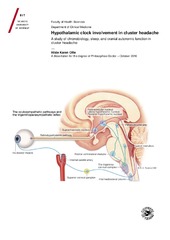| dc.contributor.advisor | Alstadhaug, Karl Bjørnar | |
| dc.contributor.author | Ofte, Hilde Karen | |
| dc.date.accessioned | 2016-10-20T07:35:25Z | |
| dc.date.available | 2016-10-20T07:35:25Z | |
| dc.date.issued | 2016-10-24 | |
| dc.description.abstract | Cluster headache has been claimed to be a chronobiological disorder because of its striking periodic occurrence. This suggests that the biological clock is involved in the pathophysiology of the disease, but few researchers have studied this in depth.
In this thesis, we have studied several aspects of chronobiology in cluster headache patients. First, we assessed the periodicity of headache attacks, the frequency of sleep disturbances and shift work employment in a cluster headache population living north of the Arctic Circle, a region with extreme variations in external light. We found that the periodicity of headache was the same here as in other cluster headache populations, but we also found a high frequency of chronic insomnia and shift work occupation among the patients.
Second, we sequenced a variable number tandem repeat DNA-sequence of the clock gene PERIOD3 in cluster headache patients. This is a core clock gene mutation known to be associated with preferred daily rhythm in healthy populations. A subpopulation of patients were also chronotyped, meaning that we assessed their preferred daily rhythms through validated questionnaires. Compared to a healthy population of Norwegian students, there was no difference in PERIOD3 genotype distribution. We also did not find certain deviations in chronotypes.
Finally, we studied cranial autonomic function in the remission phase of cluster headache. Thirty patients were examined in their headache-free period, undergoing light-reflex pupillometry, ultrasound measurement of the superficial temporal artery diameter and computer-assisted retinal vessel caliber measurements of both eyes. We found a significantly reduced parasympathetic response in the pupillary light reflex on both eyes, more pronounced on the symptomatic side, compared to controls. The retinal veins were also smaller on the symptomatic side compared to the asymptomatic side, possibly caused by reduced cranial parasympathetic tone. The findings suggest a central origin of the disease, and we propose a theory of hypothalamic involvement in cluster headache pathophysiology. | en_US |
| dc.description.doctoraltype | ph.d. | en_US |
| dc.description.popularabstract | Klasehodepine er en relativt sjelden hodepinetilstand som kjennetegnes av gjentatte anfall med intense smerter bak eller rundt ett øye, og samtidig symptomer fra det autonome nervesystemet med rødt og rennende øye. Anfallene opptrer påfallende periodisk, og man antar derfor at hodepinen har sammenheng med den overordnede biologiske klokka i hjernen, som styrer de biologiske rytmene i kroppen.
I denne doktorgraden har vi sett på hvordan klokka kan være involvert i klasehodepine. Vi fant blant annet at det var påfallende mange skiftarbeidere blant pasientene, noe som kan stemme med at den indre biologiske klokka går i utakt med den ytre døgnrytmen og kan være med på å trigge hodepinen. Pasienter med klasehodepine synes imidlertid å ha samme foretrukne døgnrytme (kronotype) som kontroller, og varianter av et klokkegen (PER3) ble funnet med samme frekvens blant pasientene som i befolkningen for øvrig. Ved hjelp av pupilleundersøkelser og måling av blodkarene på netthinna på pasienter i hodepinefri fase ble det gjort funn som indikerer en permanent forstyrrelse i det autonome ervesystemet. Dette viser at klasehodepine er en kronisk sykdom, som sannsynligvis har en sentralnervøs opprinnelse.
Resultatene øker vår forståelse av patofysiologien i klasehodepine, som fortsatt er ukjent i stor grad. Forhåpentligvis kan dette gi muligheter for bedre behandling til disse pasientene på sikt. | en_US |
| dc.description.sponsorship | Somatisk forskningsfond ved Nordlandssykehuset HF | en_US |
| dc.description | The paper 3 of this thesis is not available in Munin. <br>
Paper 3: Ofte, H. K., von Hanno, T., Alstadhaug, K. B.: "Reduced cranial parasympathetic tone during the remission phase of cluster headache". Available in <a href=http://dx.doi.org/10.1177/0333102414545893>Cephalalgia 2015,
35(6): 466-77. </a> | en_US |
| dc.identifier.uri | https://hdl.handle.net/10037/9856 | |
| dc.language.iso | eng | en_US |
| dc.publisher | UiT The Arctic University of Norway | en_US |
| dc.publisher | UiT Norges arktiske universitet | en_US |
| dc.rights.accessRights | openAccess | en_US |
| dc.rights.holder | Copyright 2016 The Author(s) | |
| dc.subject.courseID | DOKTOR-003 | |
| dc.subject | VDP::Medisinske Fag: 700::Klinisk medisinske fag: 750::Nevrologi: 752 | en_US |
| dc.subject | VDP::Medical disciplines: 700::Clinical medical disciplines: 750::Neurology: 752 | en_US |
| dc.title | Hypothalamic clock involvement in cluster headache. A study of chronobiology, sleep, and cranial autonomic function in cluster headache | en_US |
| dc.type | Doctoral thesis | en_US |
| dc.type | Doktorgradsavhandling | en_US |


 English
English norsk
norsk

